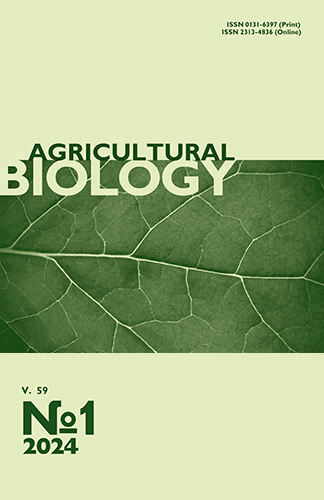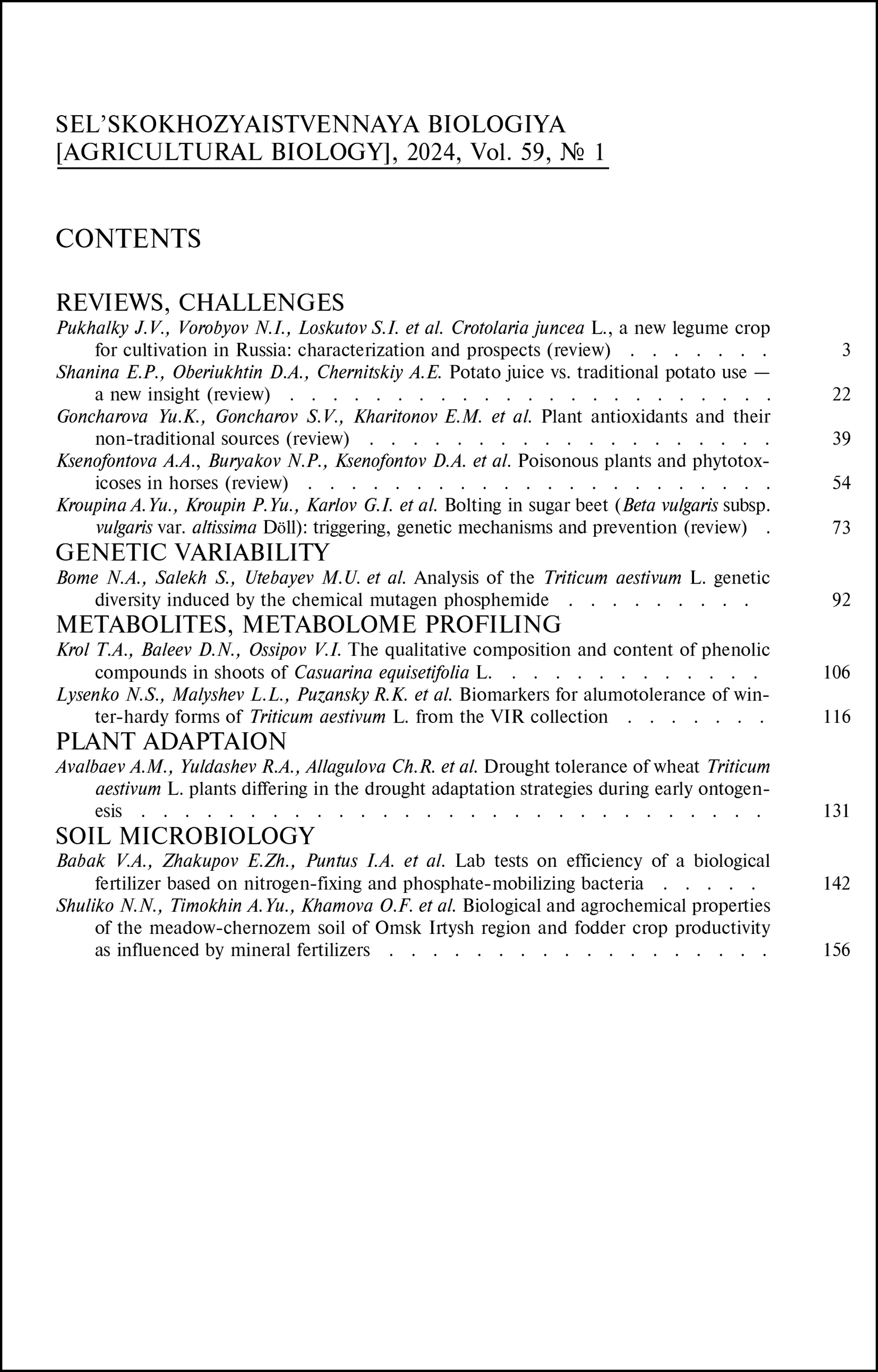doi: 10.15389/agrobiology.2024.1.92eng
UDC: 633.111.1:575.224.46.044
Acknowledgements:
The authors thank the reviewers for their contributions to the peer review of this work.
Supported financially by the project of the Ministry of Science and Higher Education of the Russian Federation No. FEWZ-2021-0007 “Adaptive ability of agricultural plants in extreme conditions of the Northern Trans-Urals”
ANALYSIS OF THE Triticum aestivum L. GENETIC DIVERSITY INDUCED BY THE CHEMICAL MUTAGEN PHOSPHEMIDE
N.A. Bome1✉, S. Salekh1, M.U. Utebayev2, K.P. Korolev1, L.I. Weisfeld3
1Tyumen State University, 6, ul. Volodarskogo, Tyumen, 625003 Russia, e-mail bomena@mail.ru (✉ corresponding author), corolev.konstantin2016@yandex.ru, samuel.biotech@yandex.ru;
2Limited Liability Partnership A.I. Barayev Research and Production Centre of Grain Farming, Republic of Kazakhstan, 021600, Akmola region, Shortandinsky District, Nauchny village, e-mail phytochem@yandex.ru;
3Emanuel Institute of Biochemical Physics RAS, 4, ul. Kosygina, Moscow, 119334 Russia, e-mail liv11@yandex.ru
ORCID:
Bome N.A. orcid.org/0000-0002-5467-6538
Korolev K.P. orcid.org/0000-0001-9595-3493
Salekh S. orcid.org/0009-0007-6907-7371
Weisfeld L.I. orcid.org/0000-0002-8449-3979
Utebayev M.U. orcid.org/0000-0003-0729-0592
Final revision received November 7, 2023
Accepted November 22, 2023
Currently, climate change and growing demand for food necessitate effective methods for crop improvement. Induced mutagenesis is a promising tool to create breeding material. This work, for the first time, established the potential of the chemical mutagen phosphemide on spring soft wheat. Particularly, it was revealed that seed treatment with an aqueous solution of the mutagen in optimal concentrations effectively increases genetic variability to select economically valuable forms. Our goal was to increase the genetic diversity of spring bread wheat (Triticum aestivum L.) using the chemical mutagen phosphemide and to determine the biological potential of mutants (M5, M6) based on the variability of morphological and productive traits under the conditions of the Northern Trans-Urals. A total of 29 spring soft wheat samples selected from mutant populations of two cultivars, Caraand Skant 3, from a hybrid (Cara × Skant 3), as well as three control cultivars, the Tyumenskaya 25, Tyumenskaya 29, Novosibirskaya 31 were involved in the study. Mutant samples were generated using the chemical mutagen phosphemide. The seeds were treated with a 0.002 and 0.01 % phosphemide aqueous solution for 3 hours. Identification of mutations and testing their stability were carried out in the second (M2) and third (M3) generations. Here, we submit data for M5 and M6 mutants grown under contrasting meteorological conditions in 2021-2022. Sowing, observations, records, description of morphological characteristics and biological properties of plants were carried out at the experimental site of the biological station of the Tyumen State University “Lake Kuchak” (Nizhnetavdinsky District of Tyumen Province). Electrophoretic analysis of gliadins was carried out in caryopsis of the 2021 harvest (M5). Based on grain electrophoretic analysis of the original and mutant plants, genetic formulas of gliadin were compiled, and the frequency of gliadin coding loci alleles (Gli) was determined. In field tests, significant differences occurred between genotypes in quantitative traits, e.g., plant height, linear dimensions and area of the flag leaf, number of productive stem per 1 m2, ear length, grain number and weight per ear. Correlation analysis revealed that the strength of the relationship between yield and other traits depends on the meteorological conditions of the growing season. The dependence of grain yield on the number of plants (r = 0.71, p < 0.05) and productive stems (r = 0.71, p < 0.05) per 1 m2, on plant height (r = 0.82, p < 0.05), chlorophyll content in flag leaf cells (r = 0.28, p > 0.05), and the number of grains per ear (r = 0.73, p < 0.05) was stronger under water and heat stress. Five mutants of spring soft wheat with a relatively high biological potential compared to other samples and standard cultivars were selected for a set of valuable traits. These mutants had the same allelic composition for gliadins. The yield was higher in 2022 and amounted to 396.1-518.2 g/m2 for the best mutants, and 355.0-424.5 g/m2 for the standard cultivars. Thus, the adaptation potential of spring soft wheat in the Northern Trans-Urals extreme conditions can be increased due to genetic variability of mutant populations. The biological effect of the chemical mutagen phosphemide has been proven to induce beneficial mutations in T. aestivum. Therefore, combination of mutational and recombination variability is effective in increasing genetic diversity.
Keywords: spring soft wheat, genotype, mutant forms, gliadin-coding loci, stress, resistance, quantitative characters, correlation.
REFERENCES
- Eastwood R.J., Tambam B.B., Aboagye L.M., Akparov Z.I., Aladele S.E., Allen R., Amri A., Anglin N.L., Araya R., Arrieta-Espinoza G., et al. Adapting agriculture to climate change: a synopsis of coordinated national crop wild relative seed collecting programs across five continents. Plants, 2022, 11(14): 1840 CrossRef
- Mutant variety database. Available: https://nucleus.iaea.org/sites/mvd/SitePages/Home.aspx. No date.
- Genetic resources in plants — their exploitation and conservation. O.H. Frankel, E. Bennett, in associations with R.D. Brock, A.H. Bunting, J.R. Harlan, E. Schreiner. Oxford and Edinburgh, 1970.
- Barrett B.A., Kidwell K.K., Fox P. Comparison of AFLP and pedigree-based genetic diversity assessment methods using wheat cultivars from the Pacific Northwest. Crop Science, 1998, 38(5): 1271-1278 CrossRef
- Van Beuningen L.T., Busch R.H. Genetic diversity among North American spring wheat cultivars: III. Cluster analysis based on quantitative morphological traits. Crop Science, 1997, 37(3): 981-988 CrossRef
- Smith J.S.C. Genetic variability within U.S hybrid maize: multivariate analysis of isozyme data. Crop Science, 1984, 24(6): 1041-1046 CrossRef
- Morgun V.V., Katerinchuk A.M., Chugunkova T.V. Izvestiya Samarskogo nauchnogo tsentra Rossiyskoy akademii nauk, 2013, 15(3/5): 1666-1669 (in Russ.).
- Rengarten G.A. Vestnik Kurskoy gosudarstvennoy sel’skokhozyaystvennoy akademii, 2022, 4: 42-46 (in Russ.).
- Metakovsky E.V. Gliadin allele identification in common wheat. 1. Methodological aspects of the analysis of gliadin pattern by one-dimensional polyacrylamide — gel electrophoresis. Journal of Genetics and Breeding, 1991, 45(4): 317-324.
- Metakovsky E.V., Novoselskaya A.Yu. Gliadin allele identification in common wheat. II. Catalogue of gliadin alleles in common wheat. Journal of Genetics and Breeding, 1991, 45(4): 325-344.
- McIntosh R.A., Yamazaki Y., Dubcovsky J., Rogers W.J., Morris C.F., Somers D.J., Appels R., Devos K.M. Catalogue of gene symbols for wheat, 2008. Available: http://wheat.pw.usda.gov/GG2/Triticum/wgc/2008/. No date.
- Dospekhov B.A. Metodika polevogo opyta (s osnovami statisticheskoy obrabotki rezul’tatov issledovaniy) [Methods of field trials]. Moscow, 2014 (in Russ.).
- Gradchaninova O.D., Filatenko A.A., Rudenko M.I. Metodicheskie ukazaniya po izucheniyu mirovoy kollektsii pshenitsy [Guidelines for studying the world’s wheat collection]. Leningrad, 1987 (in Russ.).
- Miralles D.J., Slafer G.A. A simple model for nondestructive estimates of leaf area in wheat. Cereal Research Communications, 1991, 4: 439-444.
- Lakin G.F. Biometriya [Biometrics]. Moscow, 1990 (in Russ.).
- Vaysfel’d L.I. Materialy Mezhdunarodnoy nauchnoy konferentsii «Selektsіyno-genetichna nauka і osvіta (Parієvі chitannya)» [Proc. Int. Conf. «Breeding-genetic science and lighting (Parliamentary reading)»]. Uman’, 2021: 40-43 (in Russ.).
- Vaysfel’d L.I., Bome N.A., Tatarinov F.A. Materialy Mezhdunarodnoy nauchno-prakticheskoy konferentsii «Selektsiya i genetika: innovatsii i perspektivy» [Proc. Int. Conf. «Breeding and genetics: innovations and prospects»]. Gorki, 2022: 173-180 (in Russ.).
- Sozinov A.A., Metakovskiy A.A., Pomortsev E.V. Problemy ispol’zovaniya blokov komponentov prolamina v kachestve geneticheskikh markerov u pshenitsy i yachmenya. Sel'skokhozyaistvennaya biologiya [Agricultural Biology], 1989, 1: 3-12 (in Russ.).
- Novoselskaya-Dragovich A.Y., Krupnov V.A., Saifulin R.A., Pukhalskiy V.A. Dynamics of genetic variation at gliadin-coding loci in Saratov cultivars of common wheat Triticum aestivum L. over eight decades of scientific breeding. Russian Journal of Genetics,2003, 39(10): 1130-1137 CrossRef
- Nikolaev A.A., Pukhal'sky V.A., Upelniek V.P. Genetic diversity of local spring bread wheats (Triticum aestivum L.) of West and East Siberia in gliadin genes. Russian Journal of Genetics, 2009, 45(2): 189-197 CrossRef
- Utebayev M., Dashkevich S., Bome N., Bulatova K., Shavrukov Y.Genetic diversity of gliadin alleles in bread wheat (Triticum aestivum L.) from Northern Kazakhstan. PeerJ, 2019, 7: e7082. CrossRef
- Singh N.K., Shepherd K.W., McIntosh R.A. Linkage mapping of genes for resistance to leaf, steam and stripe rust and ω-secalins on the short arm of rye chromosome 1R. Theoretical and Applied Genetics, 1990, 80: 609-616 CrossRef
- Mcintosh R.A., Yamazaki Y., Dubcovsky J., Rogers J., Morris C., Appels R., Xia X.C. Catalogue of gene symbols for wheat (12th International wheat genetics symposium). Yokohama, Japan, USDA, 2013.
- Yildirim M., Koç M., Akıncı K., Barutçular K. Variations in morphological and physiological features in wheat diallelic crosses under timely and late planting conditions. Field Crop Research, 2013, 140: 9-17 CrossRef
- Hasan M.A., Ahmed J.U., Bahadur M.M., Haque M.M., Sikder S. Effect of late planting heat stress on membrane thermostability, proline content and heat susceptibility index of different wheat cultivars. Journal of the National Science Foundation Sri Lanka, 2007, 35: 109-117 CrossRef
- Kiliç H., Yağbasanlar T. The effect of drought stress on grain yield, yield components and some quality traits of durum wheat (Triticum turgidum) cultivars. Notulae Botanicae Horti Agrobotanici Cluj-Napoca, 2010, 38(1): 164-170.
- Bijanzadeh E., Emam Y. Effect of defoliation and drought stress on yield components and chlorophyll content of wheat. Pakistan Journal Biological Sciences, 2010, 13(14): 699-705 CrossRef
- Manivannan P., Jaleel C.A., Sankar B., Kishorekumar A., Somasundaram R., Lakshmanan G.A., Panneerselvam R. Growth, biochemical modifications and proline metabolism in Helianthus annuus L. as induced by drought stress. Colloids and Surfaces B: Biointerfaces, 2007, 59(2): 141-149 CrossRef
- Schonfeld M.A., Johnson R.C., Carver B.F., Mornhinweg D.W. Water relations in winter wheat as drought resistance indicators. Crop Sciense, 1988, 28(3): 526-531 CrossRef
- Nagai T., Makino A. Differences between rice and wheat in temperature responses of photosynthesis and plant growth. Plant and Cell Physiology, 2009, 50(4): 744-755 CrossRef
- Wardlaw I.F., Dawson I.A., Munibi P., Fewster R. The tolerance of wheat to high temperatures during reproductive growth. I. Survey procedures and general response patterns. Australian Journal of Agricultural Research, 1989, 40(1): 1-13 CrossRef
- Bhullar S.S., Jenner C.F. Differential responses to high temperatures of starch and nitrogen accumulation in the grain of four cultivars of wheat. Australian Journal of Plant Physiology, 1985, 12(4): 363-375 CrossRef
- Sofi P.A., Ara A., Gull M., Rehman K. Canopy temperature depression as an effective physiological trait for drought screening. In: Drought-detection and solutions. G. Ondrasek (ed.). IntechOpen, 2019: 77-92 CrossRef
- Sohail M., Hussain I., Qamar M., Tanveer S.K., Abbas S.H., Ali Z., Imtiaz M. Evaluation of spring wheat genotypes for climatic adaptability using canopy temperature as physiological indicator. Pakistan Journal Biological Sciences,2020, 33(1): 89-96 CrossRef
- Bome N.A., Weisfeld L.I., Babaev E.V., Bome A.Ya., Kolokolova N.N. Influence of phosphomide, a chemical mutagen, on agrobiological signs of soft spring wheat Triticum aestivum L. Sel'skokhozyaistvennaya biologiya [Agricultural Biology], 2017, 52(3): 570-579 CrossRef
- Vaysfel’d L.I., Bome N.A. Biosfera, 2022, 14(3): 245-253 CrossRef (in Russ.).












